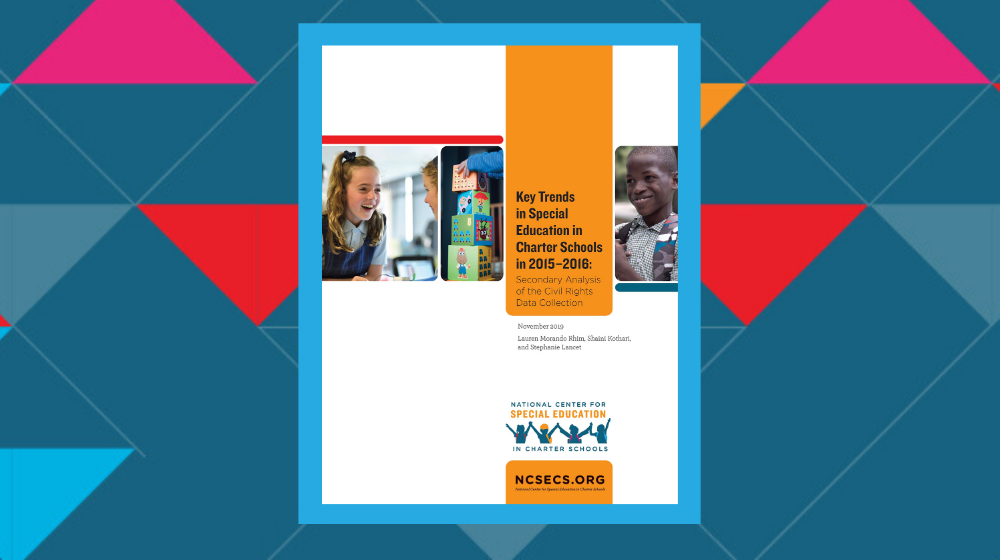The Center’s analysis highlights clear trends in how students with disabilities are accessing and being served by charter schools and offers specific recommendations for improvement.
Washington, DC — The Center for Learner Equity (the Center) released its third analysis of the Civil Rights Data Collection (CRDC) in five years and found that while charter schools are enrolling more students with disabilities than in the past and providing more inclusive learning environments, the sector continues to suspend those students at higher rates than traditional public schools and continues to enroll proportionally fewer students with disabilities compared to traditional public schools.
The report offers a longitudinal comparison documenting trends in the areas of enrollment, placement, and discipline while introducing new analyses on enrollment variance by gender and race, the impact of a charter’s legal status on enrollment and educational environment, and the growth of specialized charter schools. The Center’s Executive Director and co-founder Lauren Morando Rhim stated,
“While there are numerous factors that influence the ability of all public schools to serve students with disabilities, our analysis finds that while charter schools are making progress, they can do better. More parents of students with disabilities than ever are choosing charter schools, which is a positive sign and we believe charter schools can drive effective change so that all schools are able to provide families with the quality education, services, and supports they deserve and need.”
Key findings from the report include:
- A growing proportion of students are choosing charters: While charter schools continue to enroll proportionally fewer students with disabilities (10.79%) as compared to traditional public schools in the same states (12.84%), the difference in enrollment of students with disabilities between the two sectors has decreased over the last 10 years.
- Charters can offer more inclusive learning settings for students with disabilities: 83.5% of students with disabilities in charter schools were educated in the general education classroom for 80% or more of the day compared to 65.5% of students with disabilities in traditional public schools.
- Charters suspend students more: In general, students with disabilities are disciplined- and thus lose instructional time — approximately twice as often as their peers without disabilities across all schools. Charter schools, however, suspend a greater percentage of students with disabilities than do traditional public schools in the same states (11.85% vs. 11.32%) with the gap increasing when virtual schools are removed (12.27% vs. 11.32%)
- More students are being identified as having a disability; male and black students disproportionately: A growing proportion of students across both the traditional public and charter school sectors are being identified as having a disability. In general, across both traditional public and charter schools, male students are twice as likely to be identified as having a disability, and Black students are also disproportionately identified as having a disability (24.8% of the population but 28.4% of students with disabilities in charter schools).
- School structure matters, as charters operating as their own school district as opposed to part of a traditional district:
- Enroll a larger proportion of students with disabilities (11.28% vs. 10.17%)
- Report a larger percentage of students with disabilities spending 80% or more of their time in the general education classroom (85.35% vs. 80.31%).
- Suspend and expel students with and without disabilities at higher rates.
“We have seen that when charter schools leaders factor students with disabilities into decision making from the very beginning, schools are fully capable of offering appropriate instructional services, accommodations, and supports that enable students with a diverse array of disabilities to succeed alongside their peers,” Morando Rhim added. “It is our hope that by analyzing the data we can help key stakeholders build on the progress the sector has made and fully leverage charter school autonomy and flexibility to improve outcomes for all students.”
As the Center has done with the first two reports, the organization will use this new data with advocates, school leaders, and policymakers at the federal, state, and local levels to support collaboration to address the various systemic challenges that impact charter schools’ ability to meet students’ individual needs, maintain high standards, and cultivate innovation. The Center’s goal is to provide solid facts and to drive change in both policy and practice – that could discernibly benefit students with disabilities.

Comments are closed.